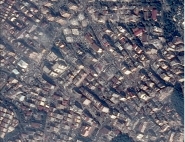Dynamic geology
Seismic risks
The current approach, using satellite systems, only concerns the study of the earthquake hazard and not that of the risk. More especially, Pleiades data can be used for prevention to identify structures and active faults, for prediction to locate seismic sources and areas of recent deformation, and for post-crisis analysis of the phenomenon and damage assessment.
Volcanic risks
![]()
The number of potentially active volcanoes on Earth is estimated at 1500, roughly 500 of which have been active over the last century and 70 of which are in eruption at the present time.
| Just as for earthquakes, volcanic activity is not a chance occurrence most of the time; it is closely linked to plate tectonics. You only have to follow the edges of these plates to draw up a world map of volcanoes: ridge volcanism (Iceland) and subduction zone volcanism (Circum-Pacific Belt). Some volcanoes, however, appear in the middle of continental and oceanic plates: this is hot spot volcanism (Hawaii, etc.). |
The human and economic damage incurred is enormous (volcanism was the cause of almost 100,000 deaths in the 20th century).
It is estimated that 10% of the world's population is directly exposed to volcanic risks, not counting the indirect effects (impact on climate, danger for air traffic, etc).
The monitoring of volcanoes is therefore a major concern for society. Despite the efforts that have been made in many countries, only a few volcanoes are monitored correctly (about 50 of the 600 listed volcanoes in the world) by permanent well-equipped observatories with qualified personnel. These observatories are generally situated in developed countries.
The current issues in terms of volcanic risks are to:
- draw up maps of exposure to hazards and risks for the volcanoes that are the most dangerous for human activity,
- develop minimum permanent monitoring of the most dangerous volcanoes,
- monitor the sequence of eruption: local impact, air safety, meteorological disturbances.
The information for predicting and assessing volcanic hazards, and for which Pleiades will supply relevant data, is as follows:
- at prevention level, identification of the active nature of certain volcanoes,
- at prediction level, the precursory signs of eruption, such as the swelling of the structure by measuring distortion, or thermal activity,
- at post-crisis report level, by mapping the damage and volcanic products, such as the size and thickness of the products emitted (ash, pyroclastic rock, mudflows, lava, etc.).
Risk of landslides - earth flows
| Ground movements (in the widest sense: mass movements of soil and rock) are a major source of natural danger. They regularly cause the death of a large number of people and can sometimes seriously damage certain elements of the economic infrastructure in countries where they occur. Ground movements are varied. They include landslides, earth flows (mudslides, lahars), etc.), rock falls , or subsidence, ground collapse and cave-ins (risk not due to natural causes), or even packing and swelling-shrinking. Ground movement dynamics are very varied: they can be slow and continuous (subsidence, packing, etc.) or fast and discontinuous (cave-ins, rock falls, rockslides, landslides, torrential lava slides, mudslides, etc.). |
The control and prevention of such phenomena is quite difficult. The movement mainly takes place deep underground, and we are generally only surface distortion can be perceived and measured. Moreover, displacement and distortion zones are discontinuous in time, precursory signs are generally misperceived and little is known of how these phenomena evolve in time.
The information concerning hazard assessment, monitoring, prediction and prevention, for which Pleiades will supply relevant data, is as follows:
- prevention - monitoring and warnings, analysis of forms and the measurement of surface displacement,
- for post-crisis observation, the propagation feedback analysis, and the inventory of damage.
